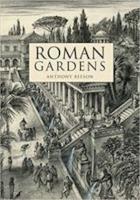
Amberley (2019) p/b 96pp £14.99 (ISBN 9781445690308)
B. is a fine arts scholar based in Bristol where he developed the Bristol Art Library into an excellent collection of art books. In terms of classical scholarship he has specialised in iconography and mosaics (notably the Boxford mosaic of Pegasus and Bellerophon). The current book sets out to describe the Romans’ enthusiasm for gardens which appears to have started to develop in and near Rome and to have flourished particularly between 100 BC and AD 300. The enthusiasm spread throughout the Empire and was displayed in domestic environments as well in and around public buildings and temples.
B. describes in comprehensive detail the various styles of decorative arts which were adopted in gardens around the Empire—particularly in relation to what would now be called ‘hard landscaping’—although a relatively ‘back to nature’ approach apparently began to emerge later in the period. Formal layouts otherwise seem to have been the norm with water features especially popular. Garden statuary was common in domestic settings, often incorporating religious symbolism (which is professionally identified by B.); similarly bird baths, sundials and mosaics. The Romans liked to place their statuary and other effects where they might be best observed from the house. Front gardens were uncommon. Every element of hard landscaping that is in use today was available to the Romans. They even used tintinnabula.
There is deliberately less information about what plants were used in the hard landscaping—contemporary illustrations seem to be the best source—although roses were clearly very popular. There was much use of raised beds, urns, trellises, pergolas and pots which may provide some clues for the modern gardener. Spaces were left in mosaics for small trees to be planted. Climatic conditions in various parts of the Empire will obviously have been a major determinant of what was planted.
B. takes a thematic approach to his exposition in ten chapters—including the pantheon of deities represented, fountains, water gardens, the Palatine and other public gardens, funerary gardens and nymphaea. The text is accompanied by 140 relevant and attractive illustrations from sites around the Empire. For classicists, most of this information is likely either to be new or to suggest a new cultural perspective and is presented in sufficiently scholarly detail; the non-classicist gardener can wonder at the hard landscaping effects achieved so long ago and may even get some new ideas. This is not a slight book and is good value at £15.
Roger Barnes
